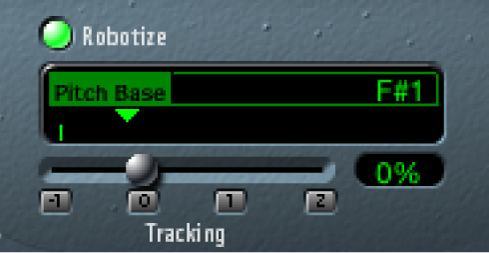Intro to Vocal Transformer in Final Cut Pro for Mac
You can use Vocal Transformer to transpose the pitch of a vocal line, to augment or diminish the range of the melody, or even to reduce it to a single note that mirrors the pitches of a melody. No matter how you change the pitches of the melody, the constituent parts of the signal (formants) remain the same.
You can shift the formants independently, which means that you can turn a vocal clip into a Mickey Mouse voice while maintaining the original pitch. Formants are characteristic emphases of certain frequency ranges. They are static and do not change with pitch. Formants are responsible for the specific timbre of a given human voice.
Vocal Transformer is well suited to extreme vocal effects. The best results are achieved with monophonic signals, including monophonic instrument clips. It is not designed for polyphonic voices—such as a choir on a single clip—or other choral clips.
Setting Pitch and Formant parameters
Use the Vocal Transformer’s Pitch parameter to transpose the pitch of the signal upward or downward. Adjustments are made in semitone steps. Incoming pitches are indicated by a vertical line below the Pitch Base field. Transpositions of a fifth upward (Pitch set to +7), a fourth downward (Pitch set to −5), or by an octave (Pitch set to ±12) are the most useful, harmonically.

As you adjust the Pitch parameter, you might notice that the formants don’t change.
The Pitch parameter is expressly used to change the pitch of a voice, not its character. If you set negative Pitch values for a female soprano voice, you can turn it into an alto voice without changing the specific character of the singer’s voice.
The Formant parameter shifts the formants, while maintaining—or independently altering—the pitch. If you set this parameter to positive values, the singer sounds like Mickey Mouse. By adjusting the parameter downward, you can achieve vocals reminiscent of Darth Vader.
Tip: If you set Pitch to 0 semitones, Mix to 50%, and Formant to +1 (with Robotize turned off), you can effectively place a singer (with a smaller head) next to the original singer. Both will sing with the same voice, in a choir of two. This doubling of voices is quite effective, with levels easily controlled by the Mix parameter.
Using Robotize mode
When Robotize is turned on, Vocal Transformer can augment or diminish the melody. You can control the intensity of this distortion with the Tracking parameter.

The Tracking slider and field work in conjunction with four buttons that immediately set the slider to the most useful values, as follows:
−1 button: Sets the slider to −100%. All intervals are mirrored.
0 button: Sets the slider to 0%. Delivers interesting results, with every syllable of the vocal clip being sung at the same pitch. Low values turn sung lines into spoken language.
1 button: Sets the slider to 100%. The range of the melody is maintained. Higher values augment, and lower values diminish, the melody.
2 button: Sets the slider to 200%. The intervals are doubled.
The Pitch Base parameter is used to transpose the note that the Tracking parameter is following. For example, with Tracking set to 0%, the pitch of the (spoken) note is transposed to the Pitch Base value.
Download this guide: PDF